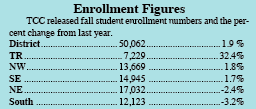By Joshua Knopp/managing editor
TCC’s enrollment continued to climb this fall to 50,062 students at the census date (the 12th class day), breaking last year’s record of 49,108 by almost 1,000.
The majority of the growth is on TR Campus, whose attendance leapt from 5,460 to 7,229, a 32.4 percent increase. SE and NW campuses each experienced 1.7 and 1.8 percent growth while NE and South attendance actually decreased by 2.4 and 3.2 percent, the first time either campus has had declining attendance since 2007 when the district as a whole lost students. These numbers are not complete as the October eight-week courses have yet to start.
TR president Tahita Fulkerson was happy with the rise in attendance on her campus.
 “We are pleased that so many of our students are choosing to take some or all of their classes on TR Campus,” she said. “Much of the spike reflects the awareness of people in the community that TCC is the best educational bargain in town.”
“We are pleased that so many of our students are choosing to take some or all of their classes on TR Campus,” she said. “Much of the spike reflects the awareness of people in the community that TCC is the best educational bargain in town.”
Fulkerson also acknowledged the nursing and allied health programs, which moved to the newly opened East Campus, and the attention they created.
“The publicity from that relocation might have put the downtown campus more in the spotlight,” she said.
Interim dean of nursing Deann Mitchell, who migrated with the program from South Campus, said the transplant doesn’t account for all of the growth. While NE and South lost about 400 students each, TR gained almost 1,800.
“We have 500 enrolled in nursing at a given time,” she said. “We’re only a small portion of that.”
Gary Smith, interim vice president of academic affairs on NE Campus, thinks multiple factors led to the decline on his campus.
“A lot of our core classes filled up,” Smith said. “It appears that even though enrollment is down, classes are filling up, so we may have to look at it on a course-by-course basis.”
The anatomy and physiology courses, for instance, both experienced a large decrease across the district, including on TR. These programs, which are prerequisites for the nursing and allied health programs, had intermediate algebra added as their own prerequisite, which Smith says led to the decline.
“I don’t think people are going to bypass their home campus to do prerequisites,” he said.
